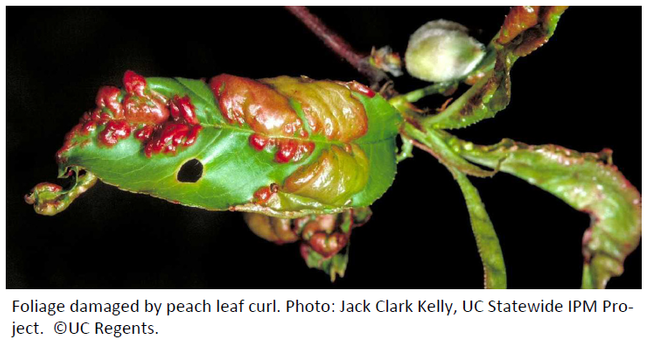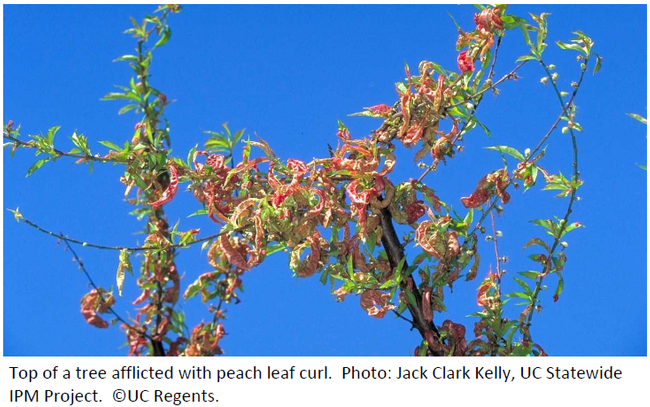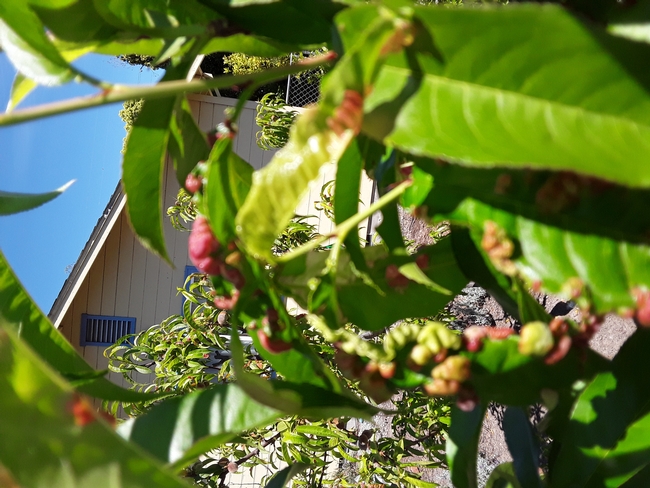Advice for the Home Gardener from the Help Desk of the
Master Gardener Program of Contra Costa County
Home Gardener's Request: Here are some recent pictures this spring of similarly affected peach trees in the County. Several home gardeners with peach trees affected with this problem have recently asked the Help Desk for any information about what this is and how to treat it.



MGCC's Help Desk Response: Thank you for the questions to the Master Gardener Program's Help Desk with your problems with your peach trees. Based upon our review, it looks like you have a very common fungus called Peach Leaf Curl. There are UC documents with links below that I urge you to read. They will help you care for your peach trees year-round which should help you control this disease.
Unfortunately, there is little you can do right now. Some pick off the distorted leaves, but there is little evidence that this improves control. The tree needs to be sprayed with a copper fungicide in the fall and again in late winter/early spring before buds break. The linked "pnleafcurl.pdf" article below will give you more specific information about proper control methods and products.
For example, it says: "Peach leaf curl, also known as leaf curl, is a disease caused by the fungus Taphrina deformans. Peach leaf curl affects the blossoms, fruit, leaves, and shoots of peaches, ornamental flowering peaches, and nectarines, and is one of the most common disease problems for backyard gardeners growing these trees.
The distorted, reddened foliage that it causes is easily seen in spring. When severe, the disease can reduce fruit production substantially...Normally, diseased leaves fall off within a few weeks and are replaced by new, healthy leaves, unless it is rainy.
If a tree is severely affected with peach leaf curl this can stunt its growth, so consider thinning fruit later in the season. Pruning in fall prior to applying any fungicides can reduce spore numbers overwintering on the tree and reduce the amount of fungicide needed. If leaf curl symptoms occurred on your trees in spring, be sure to treat the following fall and/or winter to prevent more serious losses the following year. When using pesticides, always read and follow the label for usage, rates, toxicity, and proper disposal. Proper protective clothing and gear including goggles should be used when handling any pesticides" (Emphasis mine).
I hope this information helps you get your leaf curl fungus problem under control. Your pictures do not appear to show a heavy infestation, so taking proper control methods this fall and next spring before the leaves open should prove effective.
http://homeorchard.ucdavis.edu/7261.pdf
http://ipm.ucanr.edu/PDF/PESTNOTES/pnleafcurl.pdf
Help Desk of the Master Gardener Program of Contra Costa County (TDT)
Note: The UC Master Gardeners Program of Contra Costa's Help Desk is available year-round to answer your gardening questions. Except for a few holidays, we're open every week, Monday through Thursday for walk-ins from 9:00 am to Noon at 75 Santa Barbara Road, 2d Floor, Pleasant Hill, CA 94523. We can also be reached via telephone: (925) 646-6586, email: ccmg@ucanr.edu, or on the web at http://ccmg.ucanr.edu/Ask_Us/ MGCC Blogs can be found at http://ccmg.ucanr.edu/HortCoCo/ You can also subscribe to the Blog (//ucanr.edu/blogs/CCMGBlog/).